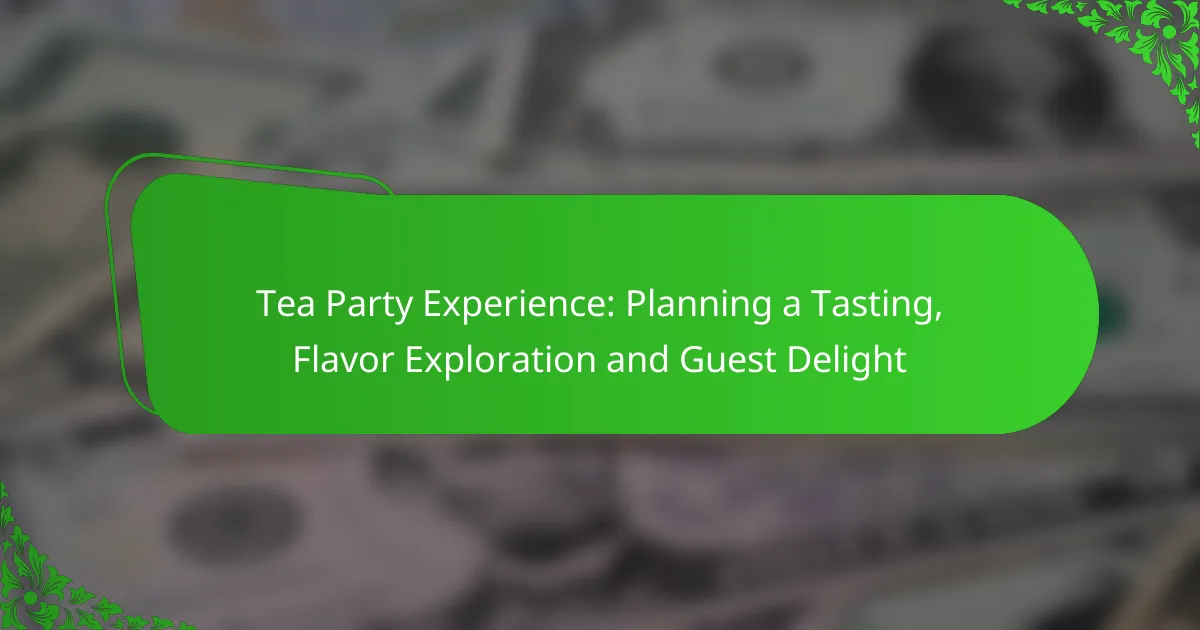Planning a tea party tasting in New York City is an exciting opportunity to immerse guests in the city’s rich tea culture while enjoying a curated selection of flavors. By exploring various types of teas, from robust black to refreshing herbal, you can create a delightful tasting experience. Enhancing the atmosphere with thoughtful decorations, food pairings, and interactive elements will ensure that your guests leave with lasting memories of their tea adventure.

How to plan a tea party tasting in New York City?
Planning a tea party tasting in New York City involves selecting an appropriate venue, inviting guests, and curating a delightful selection of teas. Consider the unique aspects of the city, such as its diverse tea culture and vibrant atmosphere, to create an unforgettable experience.
Venue selection for tea tastings
Choosing the right venue is crucial for a successful tea party tasting. Look for spaces that offer a cozy atmosphere, such as tea houses, private rooms in restaurants, or even parks for an outdoor setting. Ensure the venue can accommodate your guest list comfortably.
Consider accessibility and location; venues in Manhattan or Brooklyn may be more convenient for guests. Additionally, check if the venue provides necessary amenities like tables, seating, and tea service options.
Inviting guests and sending invitations
Inviting guests should reflect the theme and tone of your tea party. Create a guest list that includes friends, family, or colleagues who appreciate tea. Send out invitations at least two to three weeks in advance to give everyone ample time to RSVP.
Utilize digital invitations for convenience, or opt for printed ones for a more formal touch. Include details such as the date, time, location, and any specific dress code or theme to set expectations.
Choosing the right tea varieties
Selecting a diverse range of tea varieties is essential for a memorable tasting experience. Aim for a mix of black, green, oolong, and herbal teas to cater to different palates. Consider sourcing teas from local New York shops or specialty online retailers.
Provide a brief description of each tea, including its origin, flavor profile, and brewing instructions. This enhances the tasting experience and helps guests appreciate the nuances of each variety.
Creating a tasting schedule
A well-structured tasting schedule helps maintain flow and keeps guests engaged. Plan to serve teas in a logical order, starting with lighter varieties and progressing to stronger flavors. Allocate about 15-20 minutes for each tea, allowing time for discussion and notes.
Consider including breaks between tastings for guests to cleanse their palates with water or light snacks. This approach enhances the overall experience and keeps the atmosphere lively.
Setting the ambiance and decor
The ambiance and decor of your tea party can significantly enhance the experience. Choose a color scheme that complements the theme, such as soft pastels for a spring gathering or rich hues for a cozy autumn event. Use tablecloths, flowers, and elegant tea sets to create an inviting atmosphere.
Incorporate soft background music to set a relaxing tone. Ensure the lighting is warm and inviting, which can be achieved with candles or fairy lights, especially if your tea party extends into the evening.

What are the best tea flavors to explore?
Exploring tea flavors involves tasting a variety of types, each offering unique profiles. Popular options include black, green, and herbal teas, which can range from robust and bold to light and refreshing.
Popular black tea options
Black tea is known for its strong flavor and higher caffeine content compared to other teas. Some popular varieties include Assam, Darjeeling, and Earl Grey, each bringing distinct tastes influenced by their growing regions.
When selecting black teas, consider the brewing time and temperature, typically around 90-100°C for 3-5 minutes, to achieve optimal flavor extraction. Pairing black tea with milk or sweeteners can enhance its richness.
Unique herbal tea flavors
Herbal teas, made from various plants, flowers, and spices, offer a wide range of flavors. Options like chamomile, peppermint, and hibiscus provide soothing and refreshing experiences without caffeine.
Experimenting with blends can lead to delightful discoveries. For instance, combining lemon verbena with ginger creates a zesty, invigorating brew. Always check for any allergies when trying new herbal ingredients.
Green tea varieties to consider
Green tea is celebrated for its health benefits and delicate flavors. Varieties such as Sencha, Matcha, and Jasmine green tea each have unique characteristics, from grassy notes to floral aromas.
Brewing green tea requires cooler water, around 70-80°C, and shorter steeping times of 2-3 minutes to avoid bitterness. Enjoying it plain or with a hint of honey can enhance its natural sweetness.
Specialty teas from local vendors
Local tea vendors often offer specialty blends that showcase regional flavors and ingredients. These can include unique fruit-infused teas or blends featuring local herbs and spices.
Visiting local markets or specialty shops can provide opportunities to taste before purchasing. Engaging with vendors can also lead to recommendations based on personal preferences, ensuring a delightful tea experience.

How to enhance guest experience at a tea party?
Enhancing the guest experience at a tea party involves creating an inviting atmosphere, offering delightful flavors, and engaging guests in the tea tasting process. Consider elements such as food pairings, interactive stations, themed decorations, and educational materials to make the event memorable.
Pairing food with tea
Food pairing is essential for a successful tea party, as the right combinations can elevate the tasting experience. Consider light finger foods, such as sandwiches, scones, and pastries, which complement various tea flavors. For example, delicate green teas pair well with cucumber sandwiches, while robust black teas can enhance the richness of chocolate desserts.
When planning your menu, aim for a balance of flavors and textures. A mix of savory and sweet items will cater to diverse palates. Additionally, consider dietary restrictions by including gluten-free or vegan options to ensure all guests can enjoy the offerings.
Interactive tea brewing stations
Setting up interactive tea brewing stations allows guests to engage with the tea-making process, enhancing their overall experience. Provide a selection of loose leaf teas, infusers, and brewing equipment, along with clear instructions for each type of tea. This hands-on approach encourages guests to experiment with different flavors and brewing times.
Consider incorporating a variety of tea types, such as herbal, green, and black teas, to cater to different preferences. You can also offer flavored syrups, honey, and milk to allow guests to customize their drinks, making the experience more personal and enjoyable.
Creating a themed experience
A themed tea party can transport guests to a different time or place, making the event more immersive. Choose a theme that resonates with your audience, such as a Victorian tea party, a garden tea, or a cultural exploration of teas from around the world. Decorate the space accordingly, using elements like floral arrangements, vintage tableware, or cultural artifacts.
Incorporate themed activities, such as costume contests or trivia related to the theme, to encourage participation and create a lively atmosphere. This not only enhances guest engagement but also fosters a sense of community among attendees.
Providing educational materials
Offering educational materials can enrich the tea party experience by informing guests about the teas they are tasting. Provide printed guides or digital resources that explain the origins, flavor profiles, and health benefits of each tea. This not only enhances appreciation but also sparks conversation among guests.
Consider hosting a brief presentation or discussion about tea history or brewing techniques during the event. This interactive element can deepen guests’ understanding and enjoyment of the tea, making the gathering more than just a tasting but also a learning experience.

What are the costs associated with hosting a tea party?
Hosting a tea party involves various costs, including tea and supplies, venue rental, and catering. Understanding these expenses can help you budget effectively and create a delightful experience for your guests.
Budgeting for tea and supplies
When budgeting for tea and supplies, consider the type and quality of tea you wish to serve. Premium loose-leaf teas may cost between $10 to $30 per ounce, while tea bags can be more economical, ranging from $5 to $15 per box.
In addition to tea, factor in costs for accessories such as teapots, cups, and serving platters. You might spend around $50 to $150 on these items, depending on whether you rent or purchase them.
Cost of venue rental in New York City
Venue rental costs in New York City can vary significantly based on location and amenities. Expect to pay anywhere from $200 to over $1,000 for a small space, with higher-end venues charging more for exclusive services.
Consider whether you need a private room in a restaurant or a dedicated event space. Some venues may offer packages that include catering, which can save you money compared to renting a space and hiring a caterer separately.
Estimating catering expenses
Catering expenses for a tea party can range widely based on the menu and number of guests. A simple selection of finger sandwiches and pastries might cost around $15 to $30 per person, while a more elaborate spread could exceed $50 per person.
When estimating catering costs, consider whether you want to hire a professional service or prepare the food yourself. DIY catering can reduce costs but may require more time and effort to ensure quality and presentation.

What are the prerequisites for a successful tea tasting?
To ensure a successful tea tasting, it’s essential to have a clear understanding of the different tea types and the appropriate brewing methods. Additionally, gathering the right equipment will enhance the tasting experience and allow for a thorough exploration of flavors.
Understanding tea types and brewing methods
Familiarizing yourself with various tea types—such as black, green, white, oolong, and herbal—is crucial for a successful tasting. Each type has distinct flavor profiles and requires specific brewing techniques to bring out its best qualities.
For instance, black tea typically brews well at higher temperatures (around 90-100°C) for 3-5 minutes, while green tea is best steeped at lower temperatures (70-80°C) for 2-3 minutes. Knowing these nuances helps in achieving optimal flavor extraction.
Gathering necessary equipment
Having the right equipment is vital for a smooth tea tasting. Essential items include a kettle, teapot or infuser, measuring spoons, and tasting cups. Consider using a scale for precise measurements of tea leaves, which can significantly impact the taste.
Additionally, prepare a tasting sheet to note observations on aroma, flavor, and mouthfeel for each tea sampled. This organized approach helps guests engage more deeply with the tasting experience and fosters discussion about their preferences.










